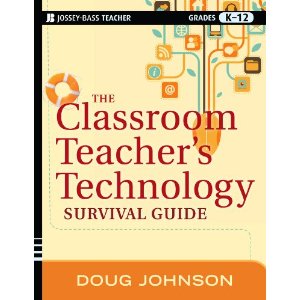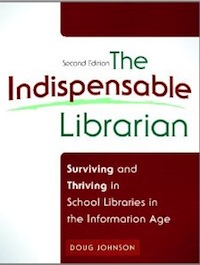Ten ways to promote online resources
Ten ways to promote online resources
Head for the Edge, Library Media Connection, August/September 2013
Doug Johnson <doug0077@gmail.com>
Online resources do not jump out at students and staff and scream “use me” any more than our library books jumped off the shelves. Digital resources also need to be promoted and displayed. The Indispensable Librarian, 2nd ed, 2013
The librarians I know are masters of promoting books to kids. Displays, contests, book talks, author visits, posters, and other far more creative tactics move books off the shelves and into kids’ hands and hearts. As librarians, we’ve had about 500 years experience in getting people to read, so we should be good at it.
But lately I have heard a different frustration expressed. After investing significant amounts of library funds on commercial online products, these tools too often go unused or underutilized.
Wouldn’t you think that today’s “digital native” [insert cynical snort here] would just automatically find and use full-text magazine services, online encyclopedias, subject specific databases, e-books, educational video providers, and other digital sources of information that are vetted and reliable?
When students ask, “Oh, you mean there are other places than Google, Wikipedia, and YouTube to find information?”, I view this as a professional failure.
While “free”, often crowd-sourced, information is readily available and popular with kids and many teachers, we as librarians have an ethical duty to “… provide the highest level of service to all library users through appropriate and usefully organized resources; equitable service policies; equitable access; and accurate, unbiased, and courteous responses to all requests.” (Code of Ethics of the American Library Association) As we move from print to digital collections, commercial online products replace our “appropriate and usefully organized resources” that once occupied the bookcases in our reference section.
If hidden deep within our webpages or our library catalogs, these resources will remain undiscovered and unused unless we proactively develop an awareness in our patrons of their availability and goodness. Can we apply some of the same techniques we use for promoting print resources to digital resources? And what new techniques do we need to use?
Here are a few starter ideas…
-
Library orientation programs must of course demonstrate online resources as well as the physical ones. Time spent online with students new to your school is as, or more valuable, as the tour of the physical facilities.
-
E-resources need to be cataloged and results of your catalog searches should provide links to them, especially e-books and subject specific databases. While true federated catalog searching - finding subject specific search results within specialized databases - may still be a few years off, there is no reason not to catalog and provide links to the titles themselves today.
-
Introductions to online resources are best done during research units themselves when students actually need the information they contain. Working with the classroom teacher, electronic resources should be identified and demonstrated at the beginning of every project.
-
Any bibliography or webquest prepared for a class should reference electronic tools as well as those in print. Oh, make the resource list an online document with live links to the tools.
-
During inservices, at teacher meetings, and in newsletters, teachers need to be informed about and trained in using these digital resources. Don’t forget parents. Okle Miller actively makes parents partners: “I have bookmarks made with the online resources including passwords and give them to parents at open house, kindergarten round up, school tours and with each book fair purchase. Parents are helping pay for these databases and other online subscriptions.”
-
Library webpages should clearly mark links to their digital resources, either on the homepage or on a separate page that has a clear link from the home page. A note by the link that tells the user any special instructions for accessing the resource not only helps the user but also cuts down on questions. Nate Schmolze, a student at the University of Wisconsin-Madison, does screencasts for the databases that demonstrate what type of content could be found in them.
-
The library’s webpage with links to its digital resources should be the home page on every web browser on library computers.
-
Students and teachers can be reminded of the schools’ online resources if guides in the form of posters are visible near workstations. Bookmarks with this information may yet have a few years of viability left.
-
Contests, including scavenger hunts, can raise the visibility of commercial online resources. Tie your contests to a single database at a time, doing smaller contests, more often. We have Battle of the Books. How about Battle of the ‘Bases?
-
Results from surveys asking for student and staff input on the usefulness of current e-resources are critical for collection building. Even with active promotions, e-resources that do not support the curriculum will go unused.
Just because a resource doesn’t fit in a display case, doesn’t mean you can’t make it visible. It just takes a little more ingenuity.




